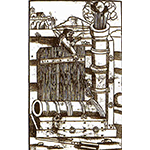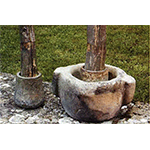Ecomuseo del Casentino - Museo della Polvere da Sparo e del Contrabbando [Casentino Ecomuseum - Museum of Gunpowder and Smuggling]
Opened in 2001 and part of the Casentino Ecomuseum Woods Network, the Museum illustrates the activity of producing and trading gunpowder, which thrived on the territory of Chitignano as of the mid 19th century.
The first section illustrates both the manual and industrial procedure of producing gunpowder, obtained by mixing charcoal, saltpetre and sulphur in different proportions. Industrial production was based on the use of binary barrels, that is to say cylindrical containers where, by means of rotation, the charcoal was ground up and mixed, on one side with saltpetre and, on the other, with sulphur. The two solutions so obtained were placed in ternary barrels where the three elements were mixed until they formed a dense mass. The mixture so obtained was, in turn, compressed, reduced into granules and prepared for drying. In the manual procedure, the three elements were ground separately in stone mortars, called tamping basins; they were then mixed and, finally, reduced into granules of various sizes, and dried in the sun.
The second section illustrates the official and clandestine productions of gunpowder. The largest authorised powder-mills were those of Prati and Ciofi. Sited along the Rassina stream, the former was equipped with machines powered by electric current in the first years of the 20th century. In 1944, the factory was destroyed by the Germans and was not rebuilt. The Ciofi factory started operation in 1869 and was equipped with machinery driven by hydraulic force, supplied by the Rassina stream. This plant too, was destroyed by the Germans in 1944. Reopened after the war, it remained in operation until 1966. The clandestine production of gunpowder, destined to the smuggling market, employed the manual procedure, availing of numerous tamping basins scattered throughout the woods and along streams in isolated, often hard-to-reach locations.
A fascinating itinerary - the "Powder-mill of Hell" - has been laid out in the picturesque Chitignano countryside and leads to one of the largest tamping basins. This clandestine powder-mill of the mid 19th century was equipped with a water-driven hammer which was used to grind the components of the powder.
****************************
Texts by Graziano Magrini
English translation by Victor Beard
Last update 16/feb/2008





